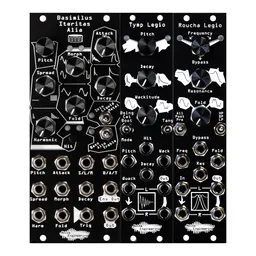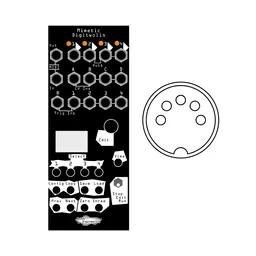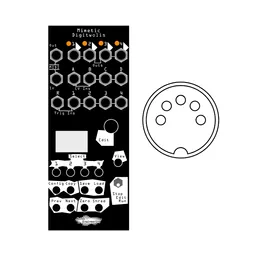Lapsus Os. One of the simplest modules we make, but somehow one of the most misunderstood. Or least understood? We get questions from people who are confused all the time, and every time we demo it, we see the aha! moment happen when people finally *get* the thing. So what is it? Let’s kvetch about LO.
At its heart, it is four channels of utility controlled by four faders. This simple interface is a wonderful tool for performance. Trust me, you should have at least one in your case since it’s just so darn fun to use. Let’s talk about some cool ways to integrate it into a dynamic control setup!
Starting off simple: just voltage
With nothing patched to either of a channel’s inputs, LO generates a 0v to 5v or -5v to 5v signal, depending on whether front-panel switch is in monopolar or bipolar mode. Each channel also includes a mult, so you can split that signal to a couple of destinations without any further patching. When I make a performance patch, I’ll often route each channel of LO to two similar parameters on different voices or controllers. For instance, maybe channel 1 controls the envelope length on two voices, and channel 2 controls a couple of filter cutoffs or other harmonic controls. This makes it easy to use in a performance, as things are grouped together in intuitive ways which makes it easy to quickly tweak something and get a predictable change without much thought.
Learn more:
A little more interesting: attenuation
Generating offsets is all well and good, but sometimes we need to make things a little bit more interesting. An easy way to do this is to patch a CV source (like Pons Asinorum or Clep Diaz) into the attenuation (X) input on a channel and then route that to a CV destination or two. This means that, for instance, we can run a filter envelope through it and quickly and easily change how much it affects the cutoff. Or, one of my personal favorite uses: using a quad modulation source like Mimetic Digitalis, we can run a different CV sequence to each channel. Then, we can route those sequences to 8 destinations, and bring them in and out with the faders on LO. Easy and fun!
Offset: WTF
Offsetting is a somewhat misunderstood part of LO. If you patch something like an envelope from PA to the offset (+) input, you have control of what voltage it starts at. Set the fader to max, and the envelope starts at 5v, goes up to 10v, then goes back down to 5v. Using the filter envelope example again, we could create a different kind of dynamic modulation using the offset input instead, to open and close the filter and then modulate it from that point.
What about both?
A common question we get is, “what happens if I patch signals to both inputs on LO? Will it EXPLODE?” Luckily, all Noise Engineering modules are 100% guaranteed to probably never explode!1,2 Ok, at least it won’t explode if you patch Eurorack signals to both of these inputs.3
Basically, the signals are summed post-fader. One signal gets attenuated by the slider, the other gets offset by the slider, and those two voltages are added together. This gets especially interesting in bipolar mode, since some modules will be negative and some will be positive and you’ll get cool averages.
REVERSIBLE?
“But Markus,” you may be saying, “I keep seeing people on my media channelz with their LOs upside down in their cases. What if *I* want to put it in my case UPSIDE-DOWN??” Not a problem! Just flip the tiny switches on each channel on the back of the module, and the jacks can be on the top or on the bottom, whatever suits your fancy. Or, if you want to get creative, flip just one and you could have one channel upside down, or something funky like that. LO works however you want it to! You do you.
Let’s see it in action
Here, we’re using three channels of LO for a few different things. Channel one controls the decay time on my kick (made by Cursus Iteritas Percido) and snare (made with Basimilus Iteritas Alter). The second channel, in offset mode, controls the offset of the filter envelope for the acid bassline (Loquelic Iteritas into Viol Ruina into Seca Ruina, modulated by two envelopes from Pons Asinorum). The third channel controls distortion for the bassline and the kick. Fun stuff!
In conclusion: one of Os! One of Os!
LO is simple in concept, but useful in almost any system. Whether you want to perform or just set up a nice modulation routing, LO has got your back. Plus, sliders! They’re fun! Go get yours!
1 But nothing in life is really ever guaranteed. 2 Terms and restrictions apply. 3 Again with the guarantees. See Note 1.






